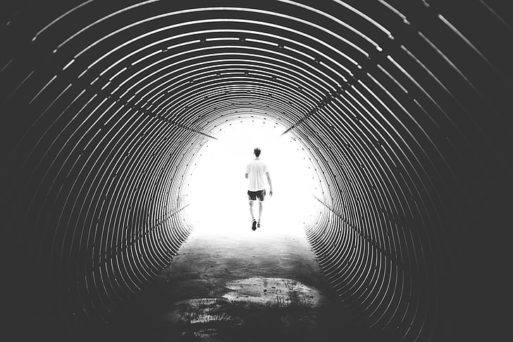
At one point or another, most of us have seen a raccoon or a squirrel that tragically attempted to cross the highway at the wrong moment. Those little, furry beings lying on the side of the road are heartbreaking to see, but at least you know they’re not suffering. They’re not in any pain. They’re dead. In those moments, death seems pretty cut and dry. Dead is dead. Except when it isn’t, of course. Near-death experiences are actually pretty complex.
Human beings, unlike any other organisms before us, have developed the skills and technology to pull people back from the very edge. After heart attacks, near-fatal accidents or emergency surgery, many people have reported intriguing, life-altering experiences. So what does it really mean to die?
In recent years, science has redefined death.
Today, a person can be considered alive even after their heart has stopped beating. That’s because the heart still has the potential to be restarted via cardiopulmonary resuscitation, or CPR. The brain, however, is less forgiving. If the brain doesn’t receive enough blood to sustain its function, the lack of oxygen will quickly cause damage. If the oxygen deprivation lasts for more than a few minutes, the brain ceases to function permanently. Brain waves flatline. At that point, it’s highly unlikely for the individual to recover, even if a heart rhythm is successfully restored.
During a critical health event, the brain doesn’t shut down instantaneously. The various parts of the brain lose function one by one, leaving the remaining “online” neurons to generate whatever electrical activity they still can. Defining exactly what’s occurring neurologically is a challenge because the brain can be damaged in so many different ways.
Some scientists believe this wave of near-death brain activity is responsible for reported near-death experiences. While this seems scientifically plausible, the puzzle pieces don’t quite fit. Theoretically, end-of-life neural activity should reflect an individual’s memories and experiences.
Strangely enough, they don’t.
Near-death experiences, according to this hypothesis, should be heavily influenced by your brain’s programming. Neurons can only generate what they already know. It follows that people from different cultural and religious backgrounds should report different near-death experiences, but most of the reports are strikingly similar.
Near-death experiences typically involve the following:
- Detachment from the physical body
- Seeing a bright light at the end of a tunnel
- Losing all sense of pain
While there are some variations between reports, many people have been able to accurately describe vivid details of the medical staff in the operating room. Some have even described the actions and words of family members who were in completely different parts of the hospital — all while they themselves were completely unconscious.

Those who have had near-death experiences often describe a floating sensation.
Interestingly, the descriptions of near-death experiences were extremely similar between atheists and devoutly religious individuals. Brain wiring doesn’t appear to have much of an impact on one’s end-of-life experience at all.
In one study in 2017, researchers spoke with 122 people who experienced near-death experiences. In the study, they compared memories of near-death experiences with real experiences from the same time period. Almost universally, the near-death experiences were described in far more detail. To those who experienced them, they weren’t imaginary in the slightest. They were as real as it gets.
Near death experiences raise questions science can’t yet answer.
Firstly, the body is hard-wired to fight for survival. When we’re in danger, we experience intense, visceral fear. How is it possible for a complete lack of oxygen to inspire feelings of bliss, rather than terror?
Secondly, if these bizarre experiences are merely the result of misfiring brain cells, how can individuals with polar-opposite ways of thinking share almost identical experiences?
Lastly, with so many people describing details they have no scientifically explainable way of knowing, is there something scientists still don’t know about what it means to die?
The answer to the final question is an indisputable “YES.”
Historically, scientists have believed that there is no life after death. When your brain dies, you die. That’s it. Your identity is gone. While no one can truly share what it’s like to die permanently, those who have partially crossed that bridge and lived to tell the tale suggest that consciousness is much more complicated than scientists once believed. What happens “next” is more complicated than any single religion can explain, either.

Do flowers die when they wilt, or when they are first cut? Death is a little fuzzy even for flowers.
We may not have all the answers, but the experiences of those who returned from the dead bring us to an encouraging conclusion: There’s something more universal, more beautiful, and more human about death than any scientist or priest can explain. The next time I narrowly miss a deer on the I5, maybe I’ll stop and ask him what he saw.
To learn more about what near-death experiences are really like, check out the Netflix series “Surviving Death.” Some of the retellings are out of this world.

 Science Has Yet to Explain Near-Death Experiences
Science Has Yet to Explain Near-Death Experiences


 First the Wealth Gap, Now the U.S. Has a Growing Health Gap
First the Wealth Gap, Now the U.S. Has a Growing Health Gap
 How to Comfort A Dying Loved One
How to Comfort A Dying Loved One
 Our Annual Seven Holiday Gifts for Someone Who Is Grieving, 2024 Edition
Our Annual Seven Holiday Gifts for Someone Who Is Grieving, 2024 Edition














